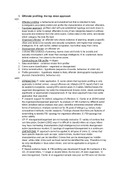1. Offender profiling: the top down approach
AO1:
- Offender profiling: a behavioural and analytical tool that is intended to help
investigators accurately predict and profile the characteristics of unknown offenders.
- Top-down approach: profilers start with pre-established typology and work down to
lower levels in order to assign offenders to one of two categories based on witness
accounts and evidence from the crime scene. Collect data on the crime, and decide
which category the data fits best.
- Organised offender: an offender who shows evidence of planning, targets a specific
villain and tends to be socially and sexually competent, with higher than average
intelligence. E.G. self control, skilled occupation, live further away from crime.
- Disorganised offender: an offender wh
- o shows little evidence of planning, leaves clues and tends to be socially and
sexually incompetent, with lower than average intelligence. E.G. unplanned, leave
behind evidence, live closer to the crime scene.
- Constructing an FBI profile: 4 stages:
1. Data assimilation - evidence review from profiler
2. Crime scene classification - organised or disorganised
3. Crime reconstruction - hypothesis (sequence of events, behaviour of victim etc)
4. Profile generation - hypothesis related to likely offender (demographic background
physical characteristics, behaviour etc)
AO3:
- STRENGTHS: P: wider application. E: some claims that top-down profiling is only
applicable to limited crimes - sexual offences etc; Meketa (2017) reports that it can
be applied to burglaries, causing 85% solved cases in 3 states. Method keeps the
organised-disorganised, but adds the interpersonal (knows victim, steals something
significant) or opportunistic (inexperienced). E: top down approach has more wider
application than assumed.
- P: research support for distinct categories of offenders. E: Canter et al (2004) tested
the organised-disorganised approach by analysis of 100 murders by different serial
killers (smallest stance analysis was used, identifies similariries between different
forms of behaviour). Analysis carried out for 39 parts of killings e.g. torture, body
concealment methods, murder weapons. Findings showed that there are features of
serial killing to identify FBI typology for organised offenders. E: FBI typology has
some validity.
- CP: P: disorganised/organised are not mutually exclusive. E: variety of combos that
can take place; Godwin (2002) says it is difficult to classify killers as a type; killers
may have contrasting characteristics (high intelligence) but commits disorgansied
action (spontanous murder). E: typology of organised-disorganised is a continuum.
- LIMITATIONS: P: approach cannot be applied to all types of crime. E: crimes that
have specific features such as rape, violent crimes, murder have visible
characteristics and can be identified. Crimes that can be stereotyped as ‘middle-
class’, white collar crime such as fraud cannot be identified this way. Therefore it may
be only identifiable in ‘blue-collar crimes’, and not be applicable to all types of
offending.
- P: flawed evidence basis. E: FBI profiling was developed through 36 murderers in the
US, 25 serial killers, 11 single or double killers. By the end, 24 were organised, 12
were disorganised. Canter et al suggested sample was poor as FBI were not diverse
, in the types of crimes their sample had committed, and no standard set of
questioning for the interviews to not have confounding variables - interviews were not
comparable. E: top down profiling does not have a scientific basis.
2. Offender profiling: the bottom up approach
AO1:
- Bottom up approach: profilers work up from evidence collected from the crime scene,
developing hypotheses on the characteristics, motivations and social background of
who the offender is. More scientific emphasis than top down approach.
- Investigative psychology: form of bottom up profiling that matches details from the
crime scene from statistical analysis of typical offender behaviours that are based on
psychological theories - the crime is recorded onto a database that is a baseline for
comparisons in patterns of behaviour in offenders and series of offences to see if it is
the same person.
- Interpersonal coherence: consistency between the way offenders interact with their
victims and others in their daily lives.
- Forensic awareness:
- Time and place: key variable, may suggest where offender is living.
- Geographical profiling: form of bottom up profiling based on the principle of spatial
consistency. An offender's operational basis and potential future crimes can be
revealed by geographical locations of their previous crimes.
- Crime mapping, spatial consistency: commiting crimes within limited geographical
space.
- Circle theory: Canter and Larkin (1993), pattern of offending form circle around
individual’s base (home). Two types:
- Marauder: operate close to home base.
- Commuter: likely to travel distance from home to commit crime.
AO3:
- STRENGTHS: P: evidence for geographical profiling. E: Lundrigan and Canter
(2001) collected information from 120 murders of serial killers showed spatial
consistency; location of body disposal created a ‘centre of gravity’, with a circular
base around offenders base; effect is more noticeable around a shorter distance
(marauders). E: geographical location can be used to identify offender
characteristics.
- P: evidence for investigative psychology. E: Canter and Heritage (1990) conducted
analysis of 66 sexual assault cases. Data examined through small space analysis
where several details were seen as common - interpersonal language, reaction to the
victim. Characteristic patterns can help identify if two or more offences were
committed by the same person. E: supports the idea of investigative psychology
(bottom up approach) that people are consistent in their behaviours.
- CP: P: linkage depends on the database, and may only have historical crimes that
have been solved. E: may have only been saved due to being straightforward to link.
E: investigative psychology may have little to do with crimes that are unsolved with
little links.
- LIMITATIONS: P: geographical profiling may not be enough on its own. E: success of
geographical profiling is dependent on the quality of data provided by the police.
Recording of crime is not always accurate/75% of crimes are not recorded.
Questions the use of an approach that relies on geographical location. Even if





